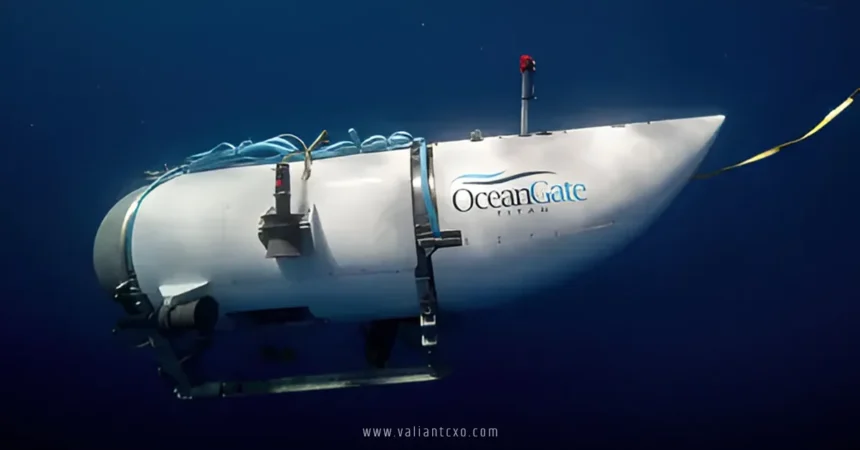The titan submersible implosion on June 18, 2023, sent shockwaves through the world, turning a thrilling adventure to the Titanic wreck into a heartbreaking catastrophe. Imagine descending over two miles into the ocean’s abyss, where pressure is so intense it could crush a car like a soda can. That’s the reality the five passengers aboard the Titan faced when their experimental submersible failed catastrophically. This article dives deep into the titan submersible implosion, exploring what happened, why it occurred, and the lessons we’ve learned from this preventable disaster. Buckle up as we navigate the murky depths of this story with a conversational lens, unraveling the facts and human elements behind one of the most publicized maritime tragedies in recent history.
What Was the Titan Submersible?
The Titan was no ordinary vessel. Operated by OceanGate, a U.S.-based company pushing the boundaries of deep-sea tourism, this submersible was designed to carry passengers to the Titanic wreck, resting 3,800 meters below the North Atlantic’s surface. Unlike traditional submersibles with spherical, titanium hulls, the Titan sported a unique cylindrical carbon fiber design. Why? To fit more people—up to five, including the pilot—making it a cozy but risky ride to the ocean floor.
OceanGate marketed the Titan as a groundbreaking way to experience the Titanic up close, charging up to $250,000 per seat. Passengers, dubbed “mission specialists,” signed waivers acknowledging the experimental nature of the vessel. But did they truly grasp the risks? The titan submersible implosion would later reveal that ambition may have outpaced safety.
Who Was On Board During the Titan Submersible Implosion?
The titan submersible implosion claimed five lives, each with a unique story:
- Stockton Rush: OceanGate’s CEO and the Titan’s pilot, Rush was a visionary who believed in pushing technological limits but faced criticism for sidestepping safety protocols.
- Paul-Henri Nargeolet: A French Titanic expert nicknamed “Mr. Titanic,” Nargeolet had visited the wreck over 37 times, bringing unmatched expertise.
- Hamish Harding: A British billionaire and adventurer with a passion for extreme exploration.
- Shahzada Dawood: A Pakistani-British businessman from a prominent family.
- Suleman Dawood: Shahzada’s 19-year-old son, reportedly hesitant but aboard to honor Father’s Day.
These individuals weren’t just passengers; they were dreamers chasing a rare glimpse of history. Their loss in the titan submersible implosion underscores the high stakes of deep-sea exploration.
The Fateful Dive: Timeline of the Titan Submersible Implosion
Let’s rewind to June 18, 2023. The Titan set off from its support ship, the Polar Prince, about 700 km southeast of Newfoundland, Canada. The mission? To visit the Titanic’s ghostly remains. For the first hour and a half, everything seemed fine. The submersible sent text updates every 15 minutes and “pings” every few seconds to confirm its position. At 2,274 meters, it reported “all good here.” But as it neared 3,346 meters—almost the Titanic’s depth—disaster struck.
At 10:47 a.m., the Titan sent its final message: “dropped two wts,” indicating it was releasing ballast to slow its descent or possibly ascend due to trouble. Seconds later, a loud “bang” echoed through the ocean, heard by the Polar Prince’s crew. Communication ceased. The titan submersible implosion had occurred, instantly killing all aboard under 4,930 pounds per square inch of pressure—equivalent to a skyscraper collapsing on a pinhead.
Four days later, a remotely operated vehicle (ROV) discovered a debris field 500 meters from the Titanic’s bow. The wreckage, including titanium endcaps and fragments, confirmed a catastrophic hull failure. The titan submersible implosion wasn’t just a malfunction; it was a violent collapse driven by the ocean’s unforgiving pressure.
Why Did the Titan Submersible Implosion Happen?
The titan submersible implosion wasn’t a freak accident—it was a tragedy born from a cascade of failures. The U.S. Coast Guard’s 335-page report, released on August 5, 2025, pointed to OceanGate’s “inadequate design, certification, maintenance, and inspection process” as the primary culprit. Let’s break it down.
Design Flaws: A Risky Blueprint
The Titan’s carbon fiber hull was its Achilles’ heel. Unlike spherical titanium hulls used in most deep-sea submersibles, which evenly distribute pressure, the Titan’s cylindrical shape concentrated stress, especially at the adhesive joints connecting the carbon fiber to titanium endcaps. Experts warned that carbon fiber, while strong in applications like airplanes, was prone to delamination and fatigue under repeated deep-sea dives.
The viewport, rated for only 650 meters, was another red flag. The Titanic lies at 3,800 meters—far beyond its capacity. Simulations by engineer Ronald Wagner showed that the hull likely fractured at these joints, triggering the titan submersible implosion in milliseconds. Think of it like a soda can under a hydraulic press: one weak point, and it’s game over.
Neglected Safety Protocols
OceanGate’s approach to safety was, to put it bluntly, reckless. The company bypassed industry-standard certifications, operating the Titan as an “experimental” vessel in international waters to dodge regulations. Previous dives revealed cracks in the first hull (Hull V1) after just 50 dives, leading to its retirement in 2019. The second hull (Hull V2), used during the fatal dive, wasn’t adequately tested for the extreme pressures it would face.
Whistleblowers, including a former director of marine operations, raised alarms as early as 2018, only to face intimidation or termination. The titan submersible implosion might have been avoided if these warnings had been heeded. Instead, OceanGate leaned on a real-time monitoring system that failed to detect critical hull weaknesses.
Toxic Workplace Culture
The Coast Guard report didn’t mince words, calling OceanGate’s workplace culture “toxic.” Employees were pressured to stay silent about safety concerns, and Stockton Rush allegedly misrepresented the Titan’s safety, claiming it was “indestructible.” This hubris, coupled with financial pressures, pushed the company to prioritize expeditions over rigorous testing. The titan submersible implosion was, in many ways, a disaster waiting to happen.
The Aftermath: Investigations and Revelations
The titan submersible implosion sparked a massive international search-and-rescue operation, captivating global audiences. Sonar, ROVs, and under-ice technology scoured the ocean floor, recovering debris and presumed human remains, later identified through DNA testing. The U.S. Coast Guard convened a Marine Board of Investigation (MBI), which held hearings in September 2024 to dissect the tragedy.
The MBI’s findings were damning. Beyond design flaws, OceanGate falsified information to secure Rush’s piloting credentials and failed to investigate hull damage from a 2022 Titanic expedition. The report recommended stronger oversight for submersibles, including mandatory certifications and whistleblower protections. The titan submersible implosion exposed a glaring gap in regulations for experimental vessels, prompting calls for reform.
Legal and Social Fallout
The families of the victims didn’t sit idly by. In August 2024, Paul-Henri Nargeolet’s family filed a $50 million lawsuit against OceanGate, alleging gross negligence. Public sentiment, reflected in posts on platforms like X, echoed outrage over ignored warnings and inadequate design. The titan submersible implosion also sparked debates about the ethics of deep-sea tourism. Is it worth risking lives for a glimpse of history? The tragedy forced the industry to confront this question head-on.
Lessons Learned from the Titan Submersible Implosion
The titan submersible implosion wasn’t just a loss of life; it was a wake-up call for the deep-sea exploration community. Here are the key takeaways:
Safety Must Come First
Deep-sea exploration is inherently risky, but the Titan’s failure showed that cutting corners is a recipe for disaster. Established protocols, like third-party certifications from organizations such as the American Society of Mechanical Engineers (ASME), exist for a reason. The titan submersible implosion underscored the need for rigorous testing and transparency.
Regulation Is Non-Negotiable
The lack of oversight for experimental submersibles allowed OceanGate to operate in a gray area. The Coast Guard’s recommendations for a Passenger Submersible Code aim to close this loophole, ensuring vessels meet strict safety standards. The titan submersible implosion could catalyze lasting change in how we regulate deep-sea adventures.
Listen to the Experts
From engineers to former employees, countless voices warned OceanGate about the Titan’s vulnerabilities. Ignoring them proved fatal. The titan submersible implosion reminds us that expertise isn’t just valuable—it’s lifesaving.
The Future of Deep-Sea Tourism
The titan submersible implosion hasn’t killed the dream of deep-sea exploration, but it’s reshaped it. Reputable operators like Triton Submarines have reaffirmed their commitment to certified designs, using spherical titanium hulls proven safe at extreme depths. Meanwhile, the public’s fascination with the Titanic endures, but the tragedy has sparked a push for stricter oversight to ensure adventures don’t turn deadly.
Imagine a future where submersibles are as safe as commercial flights, with clear regulations and robust designs. The titan submersible implosion could be the catalyst for that change, turning a tragedy into a stepping stone for safer exploration.
Conclusion
The titan submersible implosion is a haunting reminder of what happens when ambition outpaces caution. Five lives were lost in a preventable tragedy, driven by flawed design, ignored warnings, and a toxic culture that silenced dissent. Yet, from this heartbreak comes hope. The lessons learned—prioritizing safety, enforcing regulations, and listening to experts—can pave the way for a safer future in deep-sea exploration. As we reflect on the titan submersible implosion, let’s honor the victims by ensuring their loss sparks meaningful change. The ocean’s depths are calling, but we must explore them wisely.
FAQs About the Titan Submersible Implosion
1. What caused the titan submersible implosion?
The titan submersible implosion was primarily caused by inadequate design, particularly the carbon fiber hull’s vulnerability to extreme pressure, compounded by OceanGate’s failure to follow safety protocols and investigate prior hull damage.
2. Who were the victims of the titan submersible implosion?
The five victims were Stockton Rush (OceanGate CEO), Paul-Henri Nargeolet (Titanic expert), Hamish Harding (British adventurer), and Shahzada and Suleman Dawood (Pakistani-British businessmen).
3. How deep was the Titan when it imploded?
The titan submersible implosion occurred at approximately 3,346 meters (10,978 feet), near the Titanic wreck’s depth of 3,800 meters, where pressure was about 4,930 pounds per square inch.
4. Could the titan submersible implosion have been prevented?
Yes, the U.S. Coast Guard’s report concluded that the titan submersible implosion was preventable, citing OceanGate’s inadequate design, lack of certification, and dismissal of safety warnings.
5. What changes have been proposed after the titan submersible implosion?
Recommendations include stricter regulations, mandatory certifications, and a Passenger Submersible Code to ensure safer deep-sea exploration, prompted by the titan submersible implosion.
For More Updates !! : valiantcxo.com


